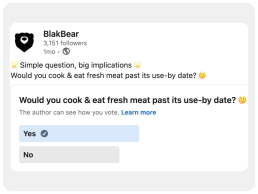Consumer habits / Poll
Would you cook & eat fresh meat past its use-by date?
We asked ~1000 people and the results have big implications on food waste!

Nearly 1000 people voted. What do the public really think?
58%
said Yes
42%
said No
A total of 966 people voted across LinkedIn, X, Instagram, and TikTok.
What does this mean?
58% of people prioritise reducing waste over fixed use-by dates.
Most people would ignore use-by dates, instead relying on their own senses.
Here’s why:

People care about food safety, but they trust their nose and eyes to check for spoilage.

Many people know that if you cook food thoroughly, it kills pathogens, making it safe. Chicken, for example, is safe to eat if cooked to an internal temperature of 75°C (165°F).

With the cost of living and food prices rising, people are increasingly unwilling to throw away food that might still be good.

Many people want to reduce their carbon footprint, so they prioritise reducing waste at home.

People understand that if you freeze meat before the Use-by, it can extend shelf life without compromising safety (although the quality may decline over time).
42% of people prioritise food safety by following use-by dates
While a majority would ignore use-by dates, a significant portion (42%) still follow them strictly.
- Risk-averse use-by dates are great for ensuring safety. They account for variations in storage temperatures, product quality, and potential bacterial growth.
- Some people prefer to play it safe. Rather than risk foodborne illness, they’d rather discard food that might still be edible.
There’s a lot of room to safely reduce food waste. Expiry dates are chosen to cover a worst-case scenario, meaning most food is still good to or cook at the date, while a lot of perfectly safe food is thrown away.
What does this mean, for the future?
Transition to digital use-by dates. Food should tell you how fresh it is.
Food waste is a huge problem:
- The UK generates 9.5 million tonnes of food waste annually (Business Waste).
- In the US, the figure is a staggering $40 billion worth of food (MITRE).
- 71% of food waste comes from food that was still perfectly edible (Business Waste).
- Edible food waste per year costs £250 per person in the UK and $1,500 per person in the US. (Business Waste, MITRE).
The future: Digital use-by dates
Instead of relying on worst-case-scenario expiry dates, food should tell you how fresh it is. BlakBear smart sensors actually measure individual pack freshness in real-time. With digital shelf-life, we can reduce waste, save money, and make food safer than ever before.
Schedule a demo
Let's shape the future of food quality and food waste.

